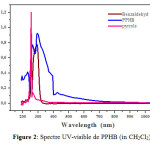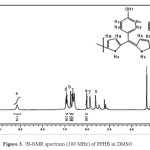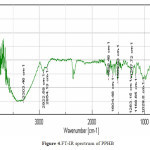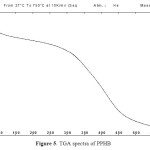Synthesis of poly[(pyrrole-2,5-diyl)-co-(4-hydroxylbenzylidene)] catalysed by Maghnite– H+
Bouhadjar Larbi1*, Aïcha Hachemaoui1,2 ,Yahiaoui Ahmed1,2, Bouchama Abdelghani1,2, Chikh Karime1, Belbachir Mohamed1
1Laboratoire de Chimie des Polymères, Faculté des sciences, Université d’Oran, BP 1524 El-Mnaouer 31000 Oran, Algérie. 2Centre Universitaire Mustapha Stambouli, Institut des Sciences et de Technologie, BP 763 Mascara 29000, Algérie.
DOI : http://dx.doi.org/10.13005/ojc/290446
Article Received on :
Article Accepted on :
Article Published : 08 Dec 2013
Rapid synthesis of poly[(pyrrole-2,5-diyl)-co-(4-hydroxylbenzylidene)] was achieve via the condensation of pyrrole and 4-hydroxylbenzylidene in dichloromethane using acid exchanged montmorillonite clay called Maghnite– H+ (Mag–H+) as an efficient catalyst The conjugated polymer was characterized by means of 1H-NMR, UV-visible, FT-IR spectroscopy and TGA.
KEYWORDS:Maghnite-H+;pyrrole-2,5-diyl,4-hydroxylbenzylidene;polymerization;conjugate polymer
Download this article as:| Copy the following to cite this article: Larbi B, Hachemaoui A, Ahmed Y, Abdelghani B, Karime C, Mohamed B. Synthesis of poly[(pyrrole-2,5-diyl)-co-(4-hydroxylbenzylidene)] catalysed by Maghnite– H+. Orient J Chem 2013;29(4) |
| Copy the following to cite this URL: Larbi B, Hachemaoui A, Ahmed Y, Abdelghani B, Karime C, Mohamed B. Synthesis of poly[(pyrrole-2,5-diyl)-co-(4-hydroxylbenzylidene)] catalysed by Maghnite– H+. Orient J Chem 2013;29(4). Available from: http://www.orientjchem.org/?p=1146 |
INTRODUCTION
Among conducting electroactive polymers, polypyrrole and its derivatives have received a great deal of attention due to its high electrical conductivity, good environmental stability, relative ease of synthesis and good redox reversibility. These properties are favourable to its applications in the areas of secondary batteries, electrocatalysis, electrochromic display devices, light-emitting devices, chemical sensors and biosensors [1–5]. However, polypyrrole and other conducting electroactive polymers are limited in practical use due to their very fragile structure and insolubility, which give rise to processing difficulties [6, 7]. Several approaches have been taken to improve processability of conducting polymers [8–11]. One effective method is to introduce insulating polymeric matrices into them due to the excellent processability of classical insulating polymers [12–18]. This can be achieved by blending, composite formation or copolymerization. Copolymerization could be a desirable way because the chemical linkage between the insulating matrix and the conjugated polymer can improve the chemical stability of the polymer [17-19]. The resulting copolymers with new functional groups showed different properties from polypyrrole homopolymer, which probably widen the application of conducting polymer. Several kinds of copolymers containing pyrrole and other insulating units, such as styrene, tetrahydrofuran, methyl methacrylate, ε-caprolactone, acryloyl chloride, etc., have been prepared and studied [20-24]. All results showed the success in improving the mechanical and physical properties of polypyrrole. However, these synthetic methods contained many steps and strict condition, leading to limited application of these copolymers. A simple and alternative way is direct electrochemical copolymerization of monomers present in the mixture in proper solution [25-28].
Recently, an Algerian proton exchanged montmorillonite clay called Maghnite–H+ (Mag–H+), a new non toxic cationic initiator, was used as a catalyst for cationic polymerization of a number of vinylic and heterocyclic monomers [29–32]. In the present work, we present a new approach to design poly[(pyrrole-2,5-diyl)-co-(4-hydroxylbenzylidene)] (PPHB) in one shot, namely by the condensation of pyrrole and 4-hydroxybenzaldehyde catalyzed by Mag–H+ (Figure 1). In contrast to most of the other conductive polymers, PPHB is a soluble polymer in common organic solvents. The catalyst can be easily separated from the polymer product and regenerated by heating at a temperature above 0°C [15].The effects of different synthesis parameters, such as the amount of Mag–H+, monomer, pyrrole, and 4-hydroxybenzaldehyde are discussed.
Experimental section
Materials
Pyrrole was purchased from Aldrich Chemical Co. and distilled under reduced pressure. Dichloromethane and 4-hydroxybenzaldehyde were used as received. MEB imaging was performed on Hitachi S 2500. The molecular structure of the polymer was characterized by FT-IR spectroscopy (Perkin-Elmer System). UV spectra were obtained by an OPTIZEN 2120 UV-Vis spectrometer using the dichloromethane solution of polymers with a concentration of 0,00125 mg/ml. 1H-nuclear magnetic resonance (NMR) measurements were carried out on a 300 MHz Bruker NMR Spectrometer equipped with a probe BB05 mm in DMSO Tetramethylsilane (TMS) was used as the internal standard in these cases.
Polymer synthesis
In a 50 ml beaker, pyrrole (8 mmol) and 4-hydroxybenzaldehyde (8 mmol) were dissolved in 10 ml of dichloromethane and a chosen amount of Maghnite–H+ was added. The weight ratio (Maghnite– H+/Pyrrole; 4-hydroxybenzylidene) was kept constant (at the desired value) in all flask. The reactions were stirred by a magnetic stirring bar, At the end of the reaction, the resulting mixture was filtered to remove the clay and then slowly added to methanol with stirring and then the polymer was dried under vacuum at room temperature for 24 h.
![Figure 1. The synthetic route of poly[(pyrrole-2,5-diyl)- co-(4-hydroxybenzylidene)] (PPHB) by Mag–H+ catalyst](http://www.orientjchem.org/wp-content/uploads/2013/12/Vol29_No3_bdjar_synth_fig1-150x150.jpg) |
Figure 1. The synthetic route of poly[(pyrrole-2,5-diyl)- co-(4-hydroxybenzylidene)] (PPHB) by Mag–H+ catalyst Click here to View figure |
Results and discussion
Most of the PPHB were found to be soluble in organic solvents such as tetrahydrofuran (THF), CH2C12, N,N-dimethylformamide (DMF), and sulfolane. Although polymers have highly conjugated chains due to the high degree of dehydrogenation, they were very soluble in organic solvents such as THF, giving grey solutions of high concentrations. The very good solubility of polymers in spite of their high degree of π-conjugation is due largely to the bulky side groups (Φ) at the methane carbon =C (Φ) link and also to the low molecular weight to some extent.
The UV-Vis absorption was recorded with an OPTIZEN 2120 spectrometer. Figure 2 shows the optical absorption spectra of polymers PPHB in CH2Cl2 solution. The colours of the polymer solution were brown or almost black. The absorption spectra in Figure 2 shows the band in the range of (300–350) nm assigned to the π-π* transition of the aromatic heterocycles since it corresponds to the same band as its precursor, and the band in the range of (400–430) nm is assigned to the π-π* transition.
 |
Figure 2: Spectre UV-visible de PPHB (in CH2Cl2). |
The 1H-NMR spectra of PPHB were obtained to further investigate and confirm the proposed structure. Figure 3 shows the 1H-NMR spectrum of PPHB in DMSO, The resonance at 10.45 ppm is assigned to the proton resonance of hydroxyl group in the benzene ring. The resonance at 9.14 ppm is assigned to the proton resonance of hydrogen in pyrrole .we observe a new proton resonance of 6.64–6.93 ppm was observed, indicating the formation of the quinoid rings in the polymer backbone, x and y are impurities. The polymers so obtained are readily soluble in common organic solvents, such as chloroform, dichloromethane, THF.
 |
Figure 3. 1H-NMR spectrum (300 MHz) of PPHB in DMSO Click here to View figure |
Figure 4 shows the FT-IR absorption spectra of PPHB. A distinct peak at 772 cm_1 of PPHB is due to the Cb–H the out-of plan vibration, characteristic of α-linkage in pyrrole ring. The peak at 1685 cm-1 of Fig. 4 is assigned to the C=C and the stretching vibration of aromatic in phenylene , this assignments is based on the FT-IR spectrum of pyrrole. The broad band at 3303 cm_1 is N–H stretching vibration of pyrrole ring and O–H vibration of hydroxyl on benzene ring in the side chain.
 |
Figure 4.FT-IR spectrum of PPHB Click here to View figure |
Figures 5 show the TGA curves of PPHB obtained in a helium atmosphere at a heating rate of 100 0C/min. This polymer show bad thermal stability. For example, the intrinsic PPHB has an onset of thermal decomposition of 100 0 C attributed to OH, the second at 114 0C is assigned to carbon bridge, so the PPHB is little stable at high temperature.
 |
Figure 5. TGA spectra of PPHB Click here to View figure |
Conclusions
Maghnite–H+, proton exchanged montmorillonite clay is an effective initiator for the copolymerization of 4-hydroxybenzaldehyde with pyrrole.
A novel polymer, poly[(pyrrole-2,5-diyl)-co-(4-hydroxybenzylidene)], which has a π-conjugated chain was synthesized by using Maghnite–H+ as catalyse. The resultant polymer showed good solubility in common organic solvents and good film formability. Such results may serve primarily to illustrate a new strategy to increase the solubility of low band gap polymers through the arrangement of different aromatic heterocycles in conjugated polymer backbones.
References
- Mermilliod N., Tanguy J., Petiot F.: A study of chemically synthesized polypyrrole as electrode material for battery applications. Journal of the Electrochemical Society, 133, 1073–1079, (1986).
- MacDiarmid A. G., Epstein A. J.: Application of thin films of polyaniline and polypyrrole in novel lightemitting devices and liquid-crystal devices. Photonic and Optoelectronic Polymers, 672, 395–407, (1997).
- Mao H. Y., Pickup P. G.: Electronically conductive anion-exchange polymers based on polypyrrolepreparation, characterization, electrostatic binding of ferrocyanide and electrocatalysis of ascorbic-acid oxidation. Journal of Electroanalytical Chemistry and Interfacial Electrochemistry, 265, 127–142, (1989).
- Ramanavicius A., Ramanaviciene A., Malinauskas A.: Electrochemical sensors based on conducting polymer- polypyrrole. Electrochimica Acta, 51, 6025–6037, (2006).
- Xue H. G., Mu S. L.: Bioelectrochemical response of the polypyrrole xanthine-oxidase electrode. Journal of Electroanalytical Chemistry, 397, 241–247, (1995).
- Lindenberger H., Schafer-Siebert D., Roth S., Hanack M.: Synthesis and properties of polypyrrole prepared by electrochemical polymerization of alpha-bipyrrole. Synthetic Metals, 18, 37–41, (1987).
- Qian R. Y., Qiu J. J., Shen D. Y.: Conducting polypyrrole electrochemically prepared from aqueous-solutions. Synthetic Metals, 18, 13–18, (1987).
- De Paoli M. A., Gazotti W. A.: Conductive polymer blends: Preparation, properties and applications. Macromolecular Symposia, 189, 83–103, (2002).
- Li Y. F., Ouyang J. Y.: Effect of nonionic surfactant additives on the electropolymerization of pyrrole in aqueous solutions. Synthetic Metals, 113, 23–28, (2000).
- Corres M. A., Mulgica A., Carrasco P. M., Cortazar M. M.: Effect of crystallization on morphology-conductivity relationship in polypyrrole/poly(epsiloncaprolactone) blends. Polymer, 47, 6759–6764, (2006).
- Balci N., Toppare L., Akbulut U., Stanke D., Hallensleben M. L.: Polypyrrole grafts synthesized via electrochemical polymerization. Journal of Macromolecular Science: Pure and Applied Chemistry, 35, 1727–1739, (1998).
- Lee Y., Shin D., Cho J., Park Y. H., Son Y., Baik D. H.: Ionic interactions in polyacrylonitrile/polypyrrole conducting polymer composite. Journal of Applied Polymer Science, 69, 2641–2648, (1998).
- Levine K. L., Iroh J. O.: Resistance of the polypyrrole/ polyimide composite by electrochemical impedance spectroscopy. Journal of Porous Materials, 11, 87–95, (2004).
- Yin W. S., Yan T. J., Gan L. M., Chew C. H., Liu H. W., Gan L. H.: Conductive composite films based on polypyrrole and crosslinked poly(styrene butyl acrylate acrylic acid). European Polymer Journal, 34, 1763–1766, (1998).
- Mano V., Felisberti M. I., Matencio T., DePaoli M. A.: Thermal, mechanical and electrochemical behavior of poly (vinyl chloride)/polypyrrole blends (PVC/PPy). Polymer, 37, 5165–5170, (1996).
- Brahim S., Guiseppi-Elie A.: Electroconductive hydrogels: Electrical and electrochemical properties of polypyrrole-poly(HEMA) composites. Electroanalysis, 17, 556–570, (2005).
- Park Y. H., Shin H. C., Lee Y., Son Y., Baik D. H.: Formation of polypyrrole copolymer in PSPMS precursor film by electrochemical polymerization. Molecular Crystals and Liquid Crystals Science and Technology: Section A, Molecular Crystals and Liquid Crystals, 327, 221–224, (1999).
- R. Soleymani, M. Taheri and M. Hoseynalibeygi., Orient. J. Chem., 28(2), 757-772, (2012).
- Stanke D., Hallensleben M., Toppare L.: Graftcopolymers and composites of poly(methyl methacrylate) and polypyrrole. Synthetic Metals, 73, 261–266, (1995).
- Kizilyar N., Toppare L., Önen A., Yagci Y.: Conducting copolymers of polypyrrole /polytetrahydrofuran. Polymer Bulletin, 40, 639–645, (1998).
- Park Y. H., Kim K. W., Jo W. H.: Preparation and characterization of conducting poly(acryloyl chloride)-g-polypyrrole copolymer. Polymers for Advanced Technologies, 13, 670–677, (2002).
- Tarkuc S., Sahin E., Toppare L., Colak D., Cianga I., Yagci Y.: Synthesis, characterization and electrochromic properties of a conducting copolymer of pyrrole functionalized polystyrene with pyrrole. Polymer, 47, 2001–2009, (2006).
- Kizilyar N., Toppare L., Önen A., Yagci Y.: Synthesis of conducting PPy/pTHF copolymers. Journal of Applied Polymer Science, 71, 713–720, (1999).
- Jerome C., Martinot L., Louette P., Jerome R.: Synthesis of new pyrrole-g-epsilon-caprolactone copolymers. Macromolecular Symposia, 153, 305–319, (2000).
- Borole D. D., Kapadi U. R., Mahulikar P. P., HundiwaleD. G.: Electrochemical synthesis and characterization of conducting copolymer: Poly (o-aniline-co-otoluidine). Materials Letters, 60, 2447–2452, (2006).
- N. Nemiche, F. Z. Sebba and S. Ould-kada., Orient. J. Chem., 29(1), 97-102, (2013).
- Mu S. L.: Poly(aniline-co-o-aminophenol) nanostructured network: Electrochemical controllable synthesis and electrocatalysis. Electrochimica Acta, 51, 3434–3440, (2006).
- Dhanalakshmi K., Saraswathi R.: Electrochemical preparation and characterization of conducting copolymers: poly(pyrrole-co-indole). Journal of Materials Science, 36, 4107–4115, (2001).
- Belbachir M., Bensaoula A.: Composition and method for catalysis using bentonites US patent 6,274,527, USA, (2001).
- Yahiaoui A., Belbachir M.: Ring-opening Polymerization of Styrene oxide with Maghnite-H+ as ecocatalyst. Journal of Applied Polymer Science, 100, 1681–1687, (2006).
- Hachemaoui A., Yahiaoui A., Belbachir M.: Synthesis and characterization of of water soluble poly (Nacetyl) iminoethylene and poly (ethyleneimine) by ion- exchanged clay montmorillonite. Journal of Applied Polymer Science, 102, 3741–375,0 (2006).
- Meghabar R., Megherbi A., Belbachir M.: Maghnite-H+, an ecocatalyst for cationic polymerization of Nvinyl-pyrrolidone. Polymer, 44, 4097–4100, (2003).

This work is licensed under a Creative Commons Attribution 4.0 International License.









